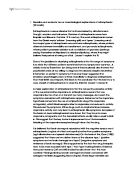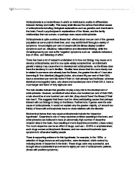Some researchers have argued that it would be a confirmation of the hypothesis if it can be demonstrated that double bind interactions occur more often in families with a schizophrenic member, than in families without a schizophrenic member. Bateson et al.'s claim that double binds typically occur in instances of intense mutual involvement between participants is supported in Blotchky et al.'s 1974 finding that conflicting messages tend be associated with extreme interpersonal closeness or distance,
Bateson et al’s (1969) empirical work on family interaction is not without its problems. By designing those studies in such a manner that confirmation of the theory depends on the ability of the double bind construct to distinguish between 'normal' and 'schizophrenic' families, it is assumed that schizophrenics and family members continuously talk in double binds, will talk in double binds when third parties are present, and that outsiders are able to detect double binds without fully appreciating the context in which the interaction occurs. A related concern is that all family interaction studies on double bind interactions conducted so far rely on randomly selected chunks of family interaction, rather than using complete interactional episodes, thereby limiting the ability to investigator to detect contradictory patterns of interaction. It is especially important to consider this latter point because it does not necessarily follow from double bind theory that double binds occur very often (Bateson, 1969). The use of larger segments of family interaction in empirical source material should be one of the priorities of double bind research in future work.
Bateson’s (1969) double bind theory would suggest that identical twins may share the disorder more often than fraternal twins because the former are double bound together more often than the latter. The reasons for possible more frequent double binding may be the greater genetic similarity of identical twins, but these more similar traits and behaviours are not necessarily related to the disorder, only to the concordance thereof. Adopted away offspring are in a potentially double binding environment, and may be even more so if contact with the biological family remains. Patterns of exposure to such contingencies may be different for those adoptee who have versus those who do not have the disorder. Medical records typically do not contain enough information to decide on such issues, and the interviews with relatives conducted in the Finnish and Danish adoption studies primarily served to diagnose them, rather than to obtain information about the adoption process itself.
's (1969) double bind theory is very complex, and has only been partly tested; there are gaps in the current and experimental evidence required to establish . Current subjective assessments of individuals, faced with making a serious decision while exposed to conflicting messages, report feelings of . It is argued that if the double bind theory is indeed to overturn findings indicating a genetic basis for , more comprehensive psychological and experimental studies are needed, with different family types and across various family contexts. The current understanding of schizophrenia takes into account a complex interaction of genetic, neurological as well as emotional stressors, including family interaction.
One of the most famous and most debatable genetic theories is the dopamine hypothesis Wise & Stein (1973). The proposed hypothesis states that the brain of schizophrenic patients produces more dopamine than normal brains. It is this increased dopamine that is believed to be responsible for the symptoms of the disease. However, the is much debate in the scientific community as to the exact mechanism by which altered dopamine levels, especially in the prefrontal cortex, striatum, and limbic system, produce schizophrenia. There is much clinical evidence that provides support for the dopamine hypothesis. The first evidence that dopamine may be involved in schizophrenia came from amphetamine users. Amphetamines work by causing the brain to produce more dopamine and have been shown to produce psychotic-like symptoms. In addition, traditional anti-psychotic drugs, such as haloperidol and chlorpromazine, act by blocking dopamine receptors in the brain. However, there are some problems with this evidence. Amphetamines only mimic the positive symptoms of schizophrenia. They do not produce any of the negative symptoms. Likewise, anti-psychotic drugs are only affective on the positive symptoms of the disease. There is still some evidence that schizophrenics do possess higher levels of dopamine, however, these increases are only found in the striatum of the brain. The striatum is a region of the brain that receives its inputs from and outputs to the cortex. Injury to the striatum results in problems with initiation and control of motor behaviour.
The major support and refutation of the dopamine hypothesis has come from the examination of dopamine receptors in these regions of the brain. (Gross 1996)
While all the research seems to indicate that dopamine is somehow involved in the production of the symptoms of schizophrenia, it is difficult to determine the exact involvement. It appears that the increased levels of dopamine in the striatum are responsible for some of the positive symptoms, particularly the over activity. However, it also appears that the prefrontal cortex may be responsible for the activation of positive symptoms. The prefrontal cortex controls and organizes the information that goes to and from the cortex. Thus, a decrease in the activity in this region of the brain would result in a lack of organization of thought and perception. This would result in the hallucinations and disorganized thoughts that are often experienced by patients with schizophrenia. One researcher hypothesizes that during normal development, activity of dopamine in one region of the brain may have an inhibitory effect on the development of other dopaminergic pathways. The evidence indicates that the lack of dopamine activity in the prefrontal cortex and limbic system results in a lack of inhibition in the production of dopaminergic pathways in the striatum. There is some evidence to support this. Patients with schizophrenia have smaller frontal lobes and larger ventricles. They also have a higher incidence of head injury during childhood. Each of these factors could result in damage to the prefrontal cortex which would then result in a decrease in activity. The inactivity would then result in a lack of inhibition of the striatal pathway. This would be particularly evident in adolescence, when the prefrontal cortex finishes its development. It is the case that schizophrenia appears during adolescence and early adulthood. (Gross 1996)
Chemical imbalances theories do not presume individual laboratory tests be obtained from a patient at the time of prescription, such as one would expect in the analogy to physical medicine. For example, a schizophrenic is not given Haldol on the basis of a laboratory test which shows that his dopamine level is too high. Chemical imbalances theories distinguish, incorrectly, between 'side' and 'main' drug effects in recording the response to the drug. 'Side' effects are considered to be simple, direct, predictable, allowable effects which are merely 'physical' but do include often flattened effect and memory, emotive and cognitive effects. These drug effects may then be cited capriciously as further evidence to confirm the diagnosis as correct, confusing cause and effect. Chemical imbalance theories predominate in 'streamline' public sector medicine for lower social class and homeless persons, where drugs constitute the only form of treatment. There is much wishful thinking in attribution of drug effect, particularly in cases like schizophrenia, where there no longer exists a patient [non-drug user] control group available.
In conclusion it can be said that there is enough evidence to back up both theories. Whether or not schizophrenia is caused by genetics or social influences, the patient is still treated with the same type of medicine that controls the dopamine levels in the brain, and suppresses the symptoms of the illness. Therefore the genetic evidence seems more plausible in explaining the causes of schizophrenia as it assumes that it is the levels of dopamine that causes the patient’s symptoms but when medicated correctly there symptoms disappear.
_____________________________________________________________________
Eysenck, M (2000) Psychology, A Students Handbook: Psychology
Press Ltd: East Sussex.
Gross, R (1996) Psychology, The Science of Mind and Behaviour:
Greengal Publishing Service: Kent.









